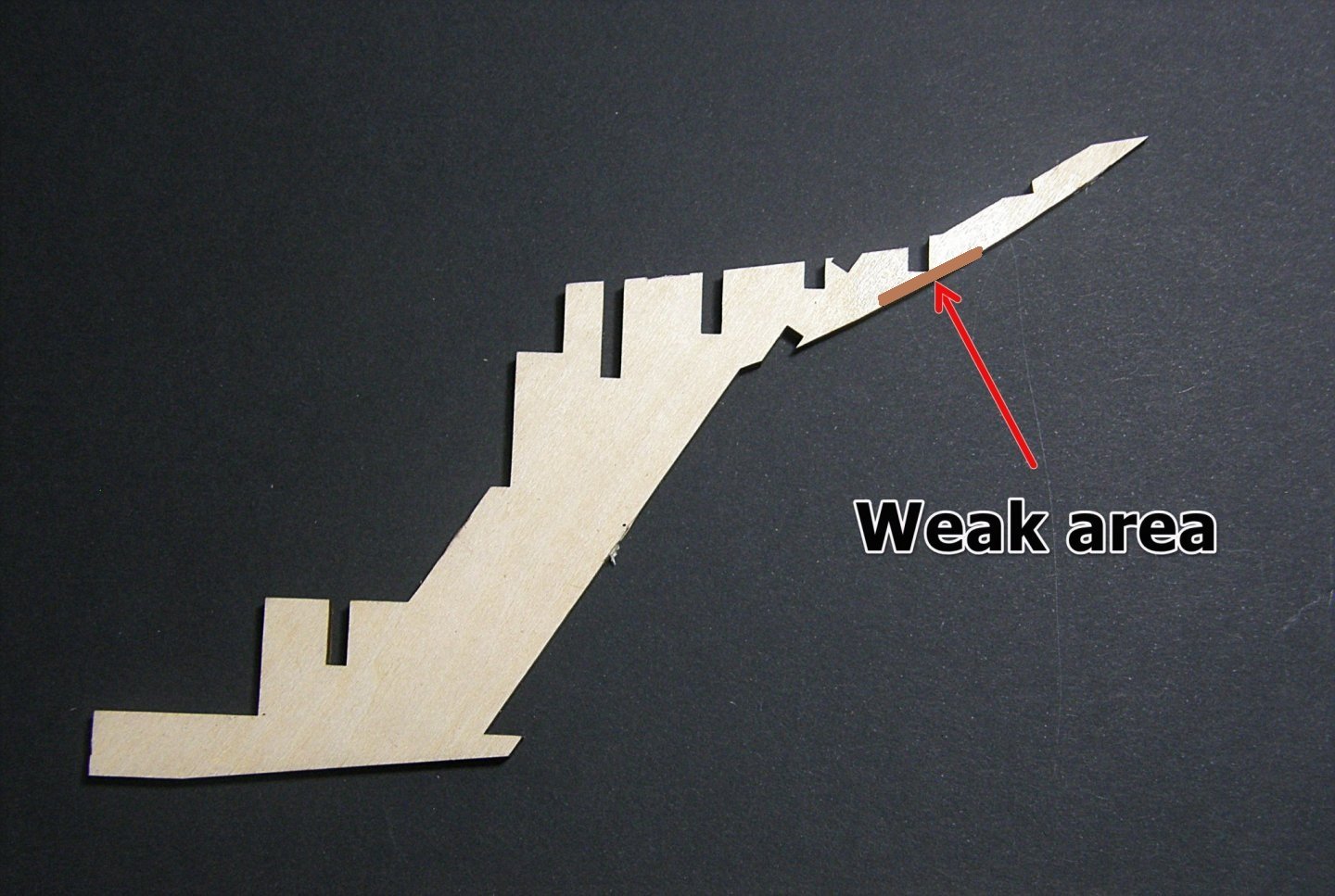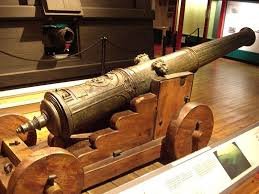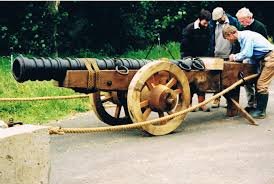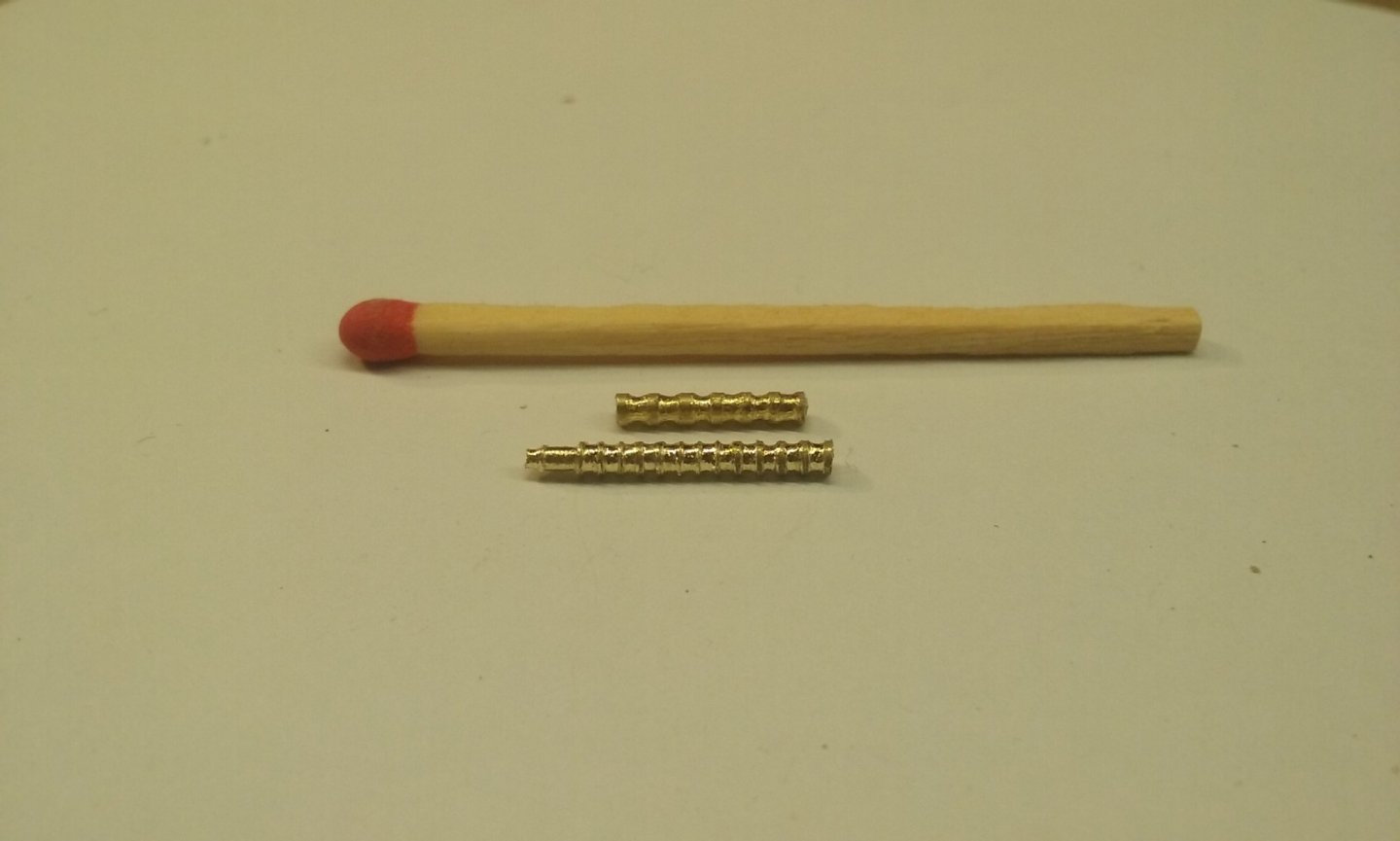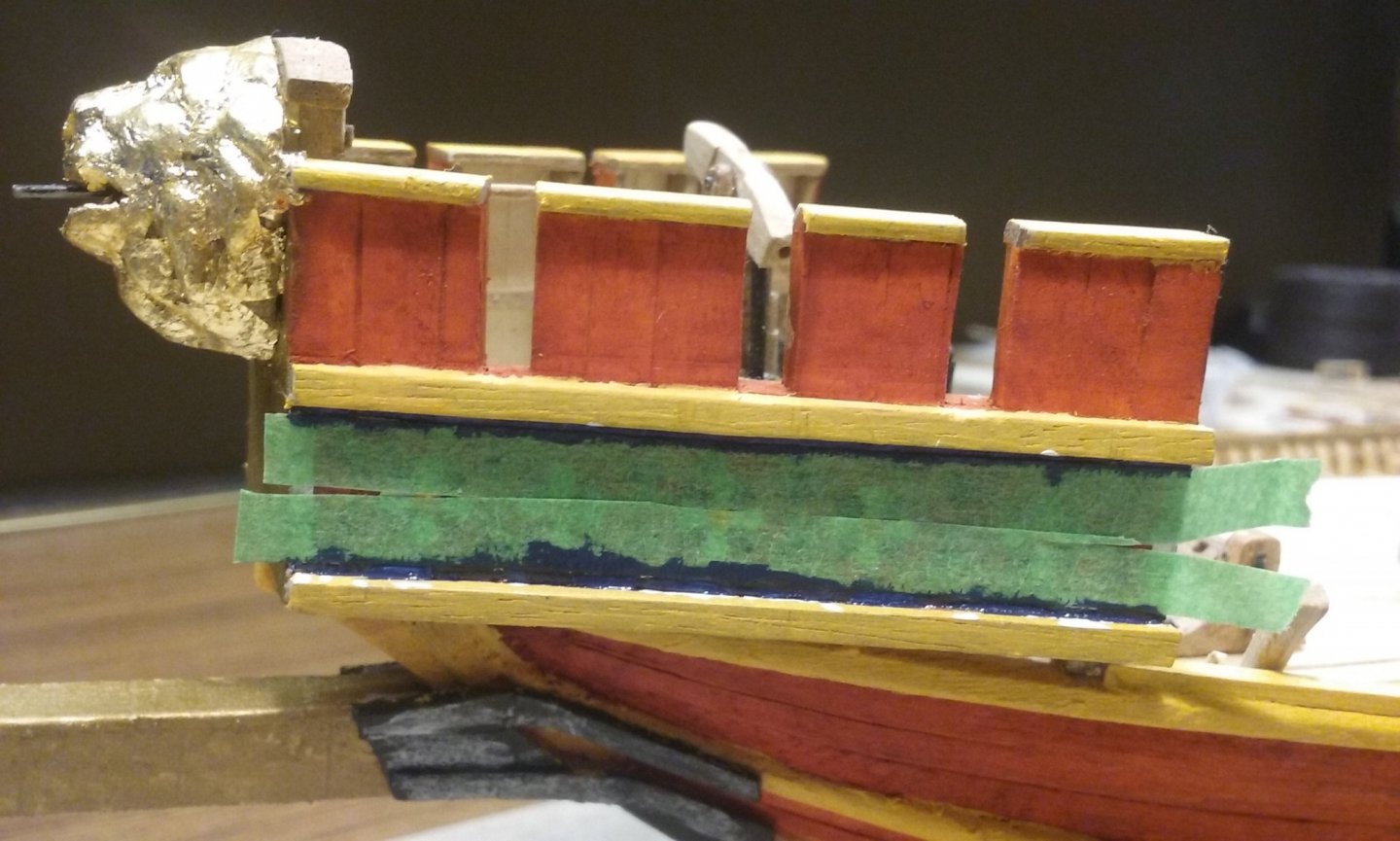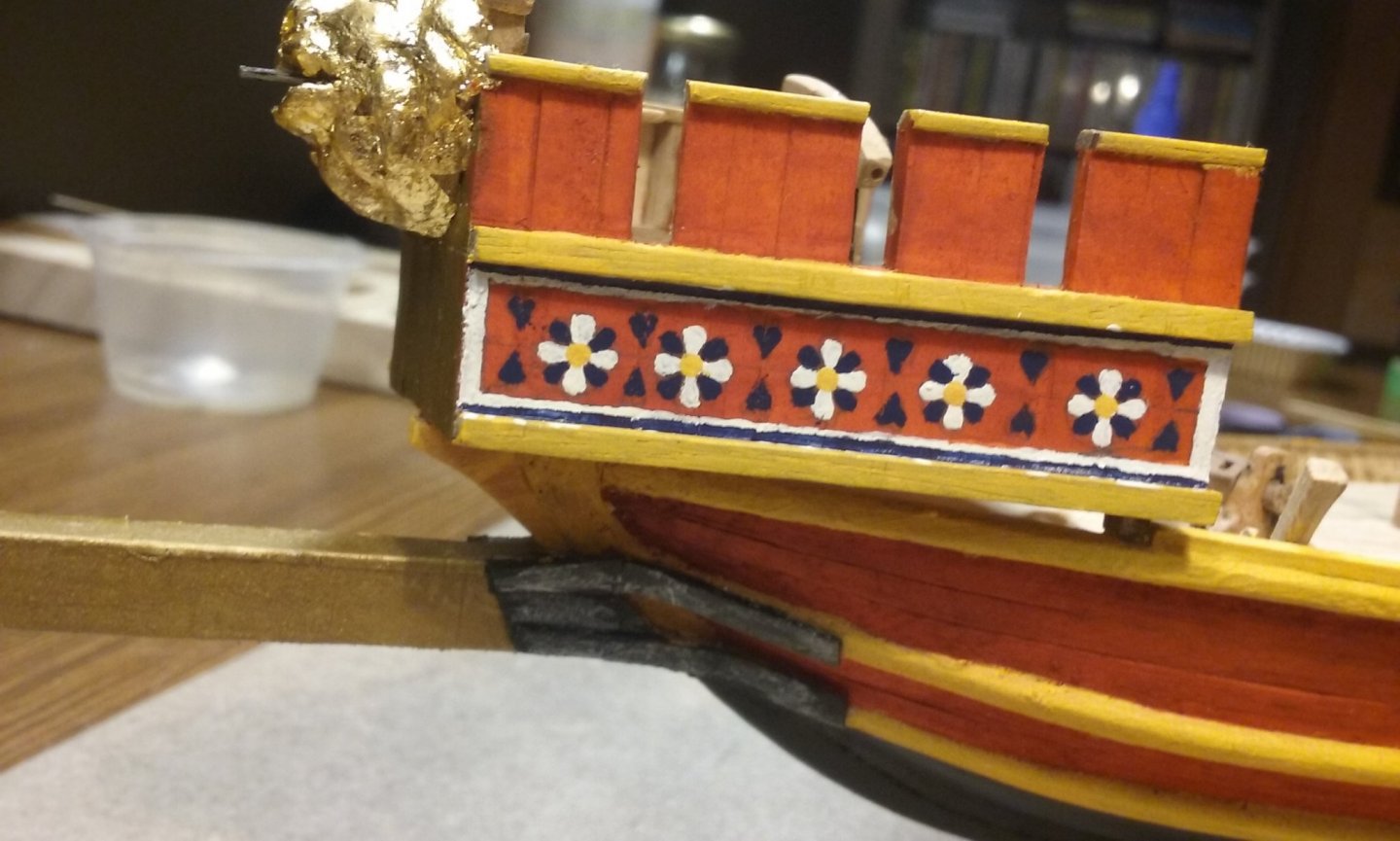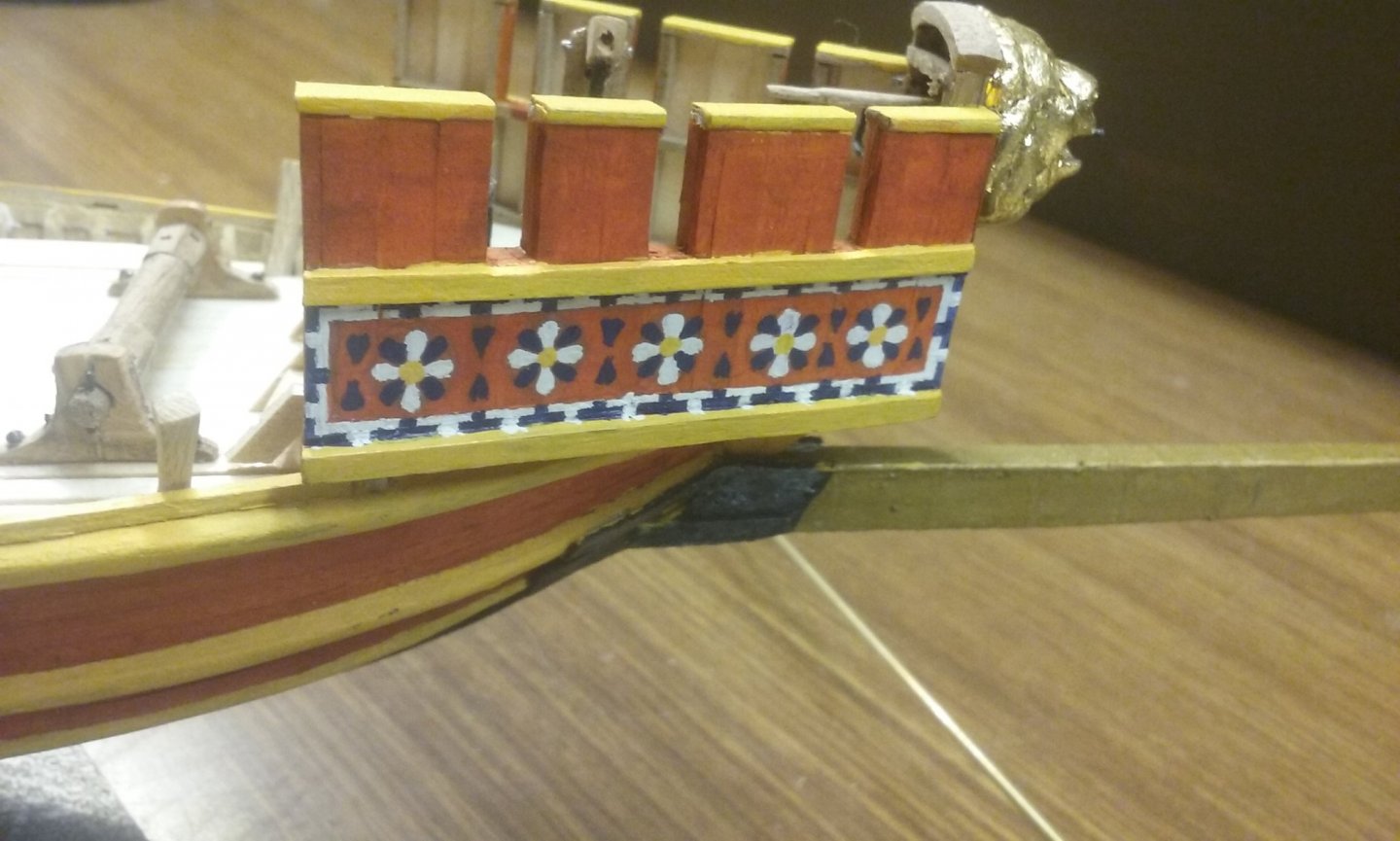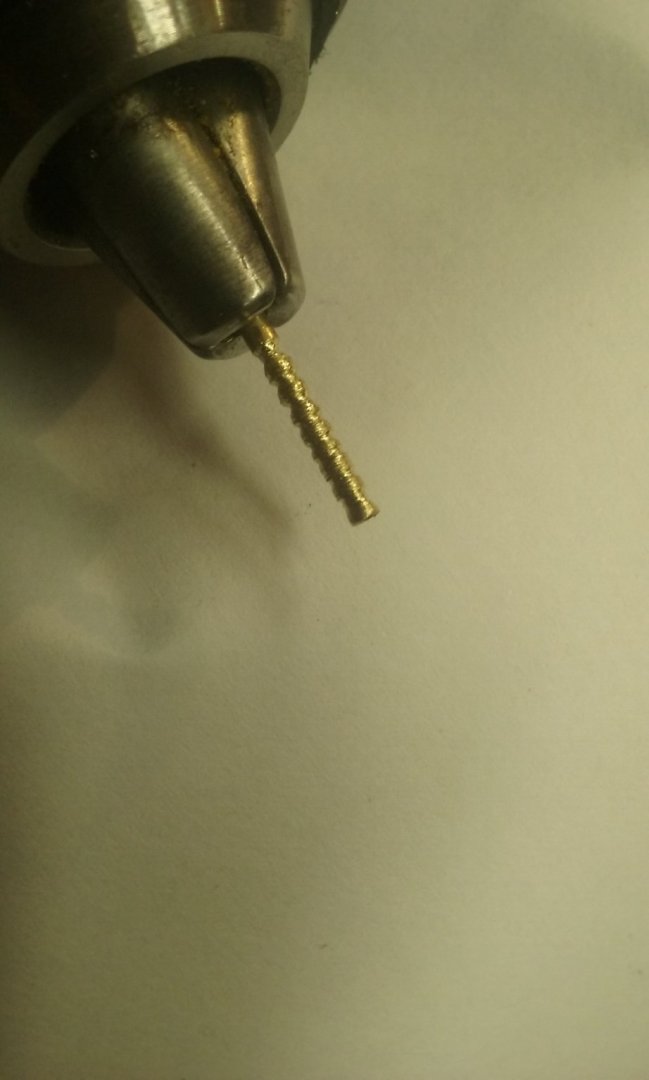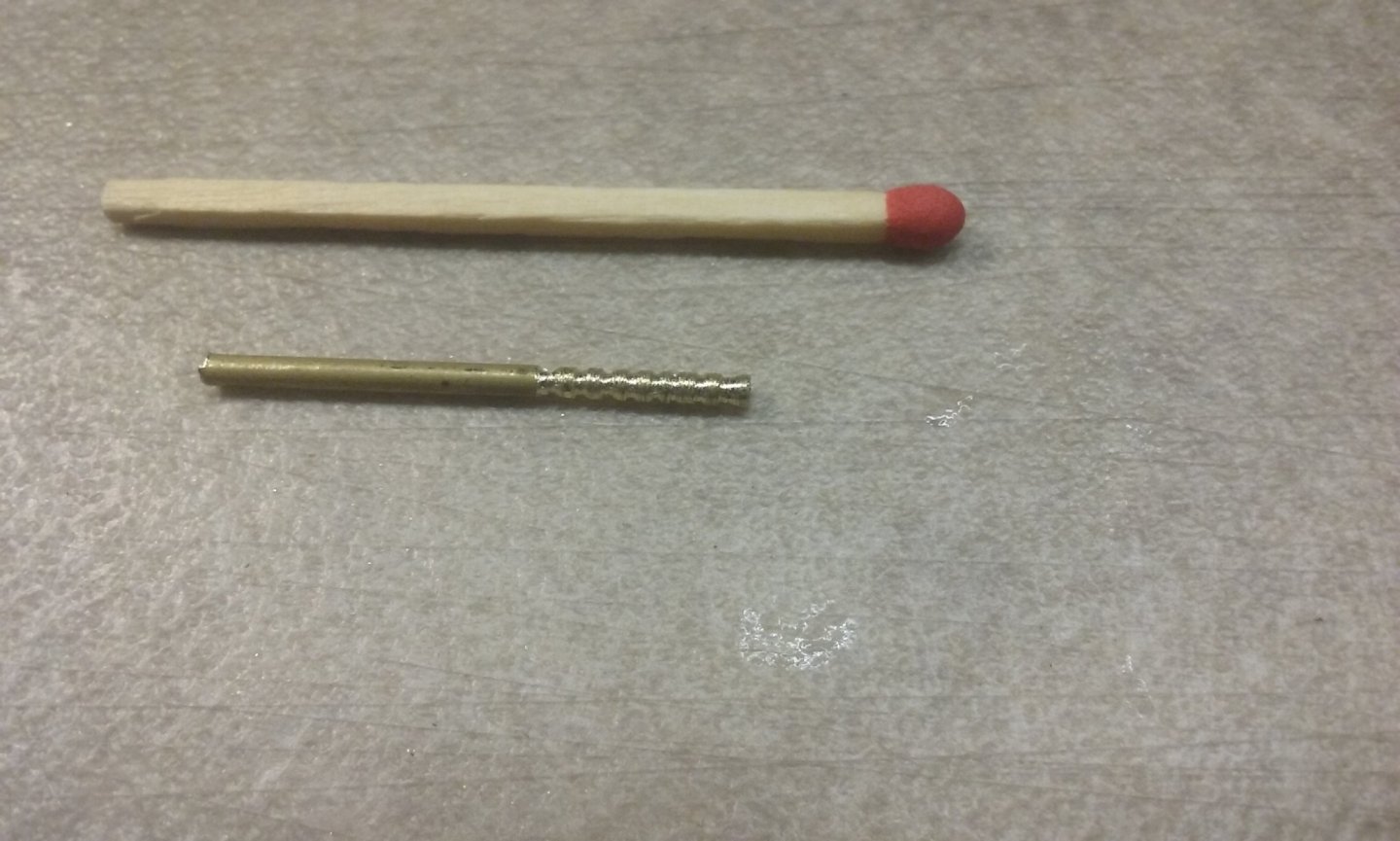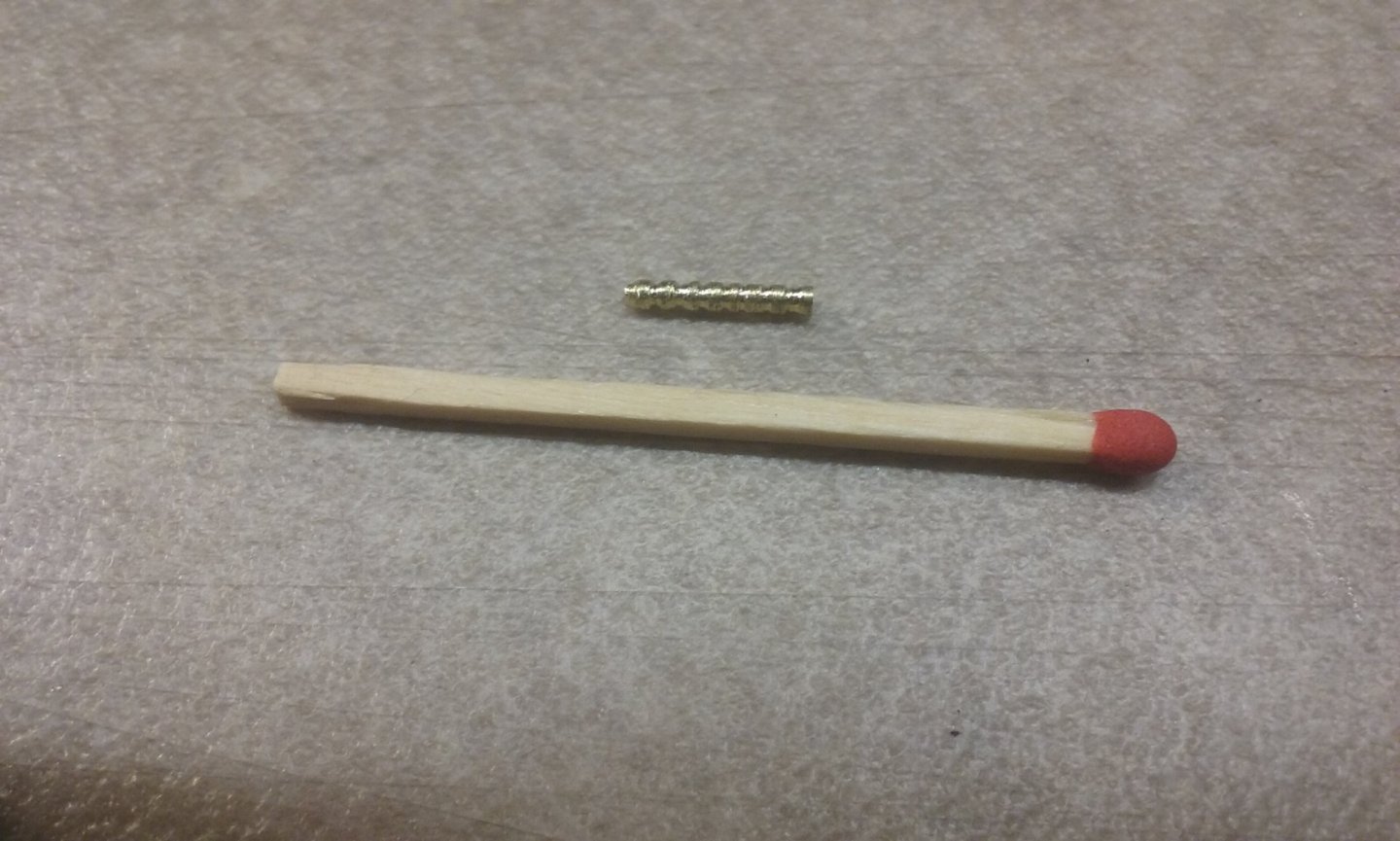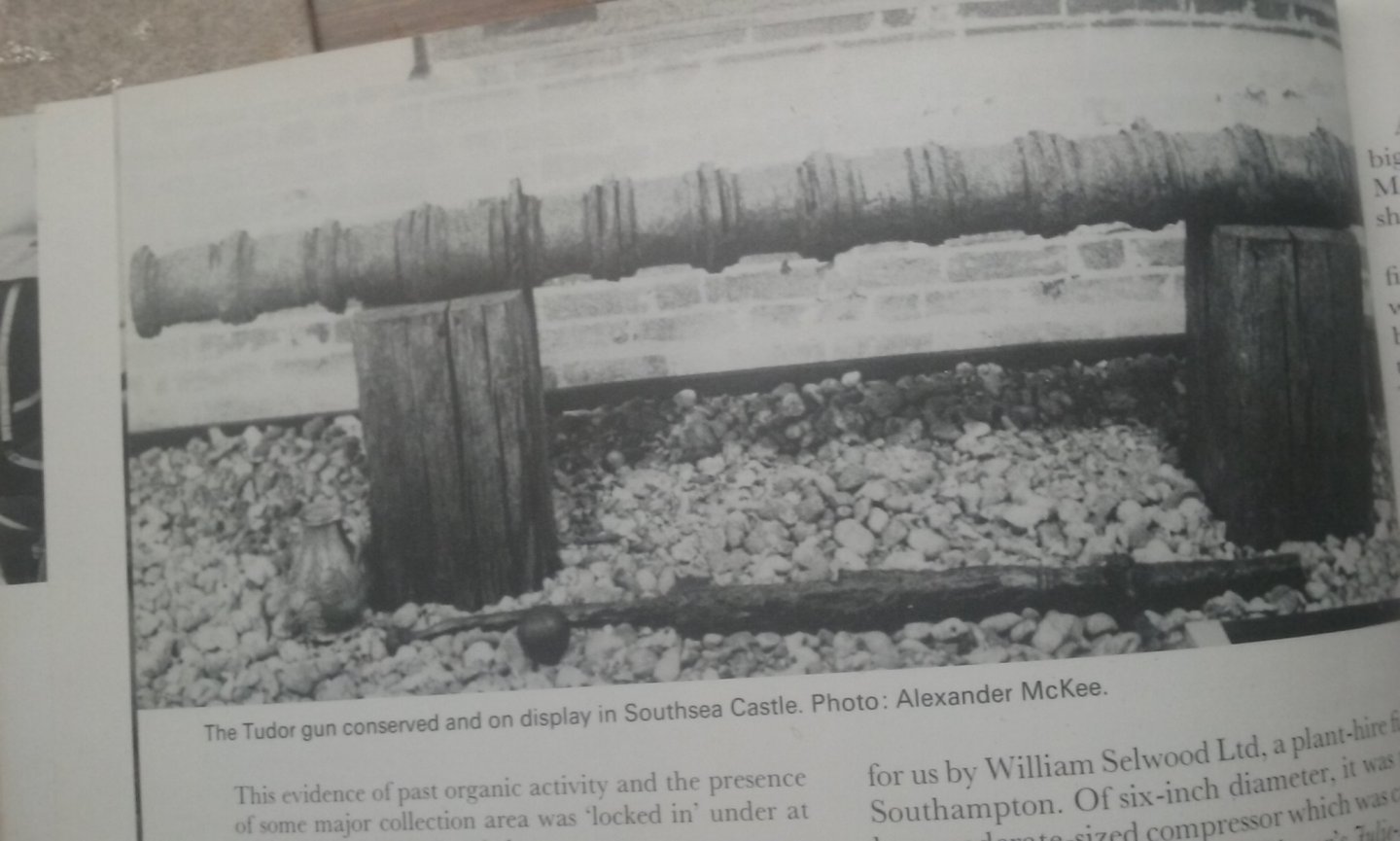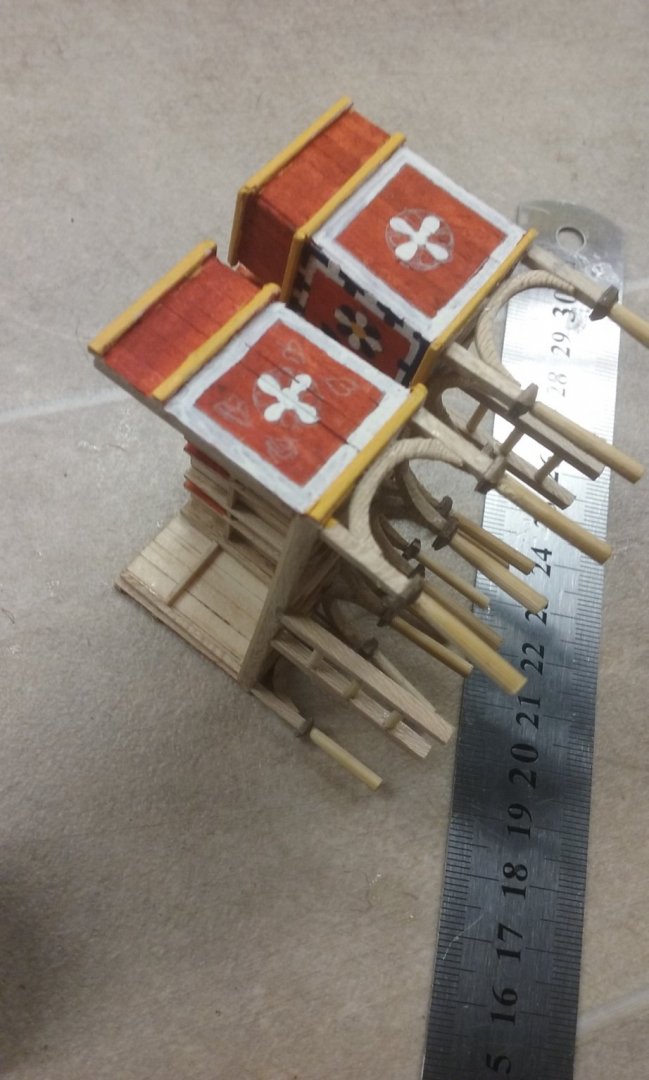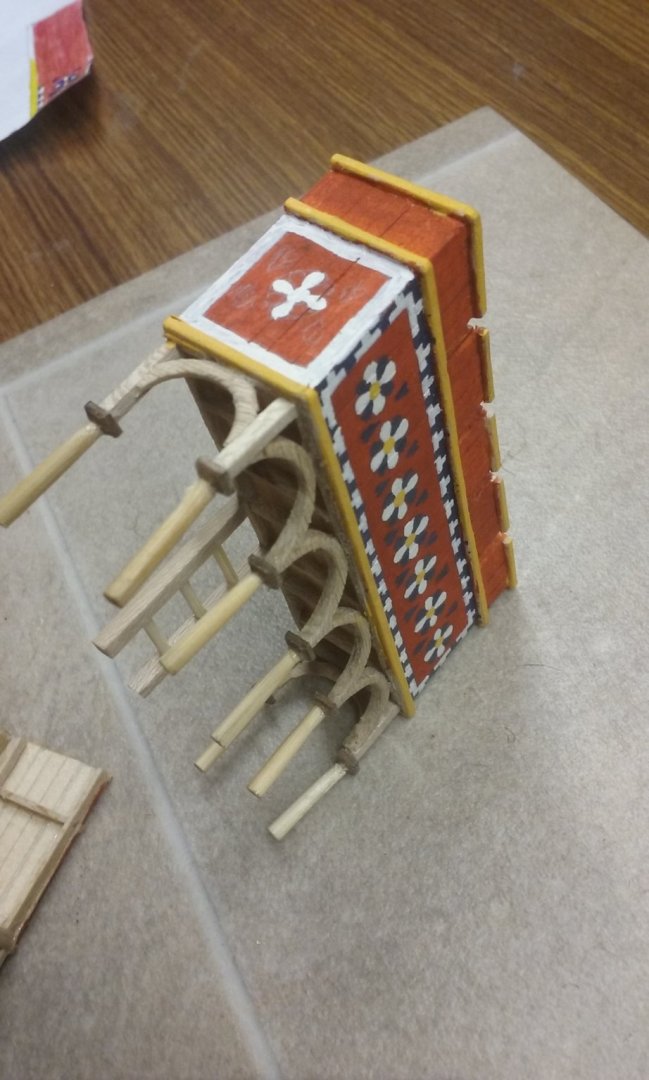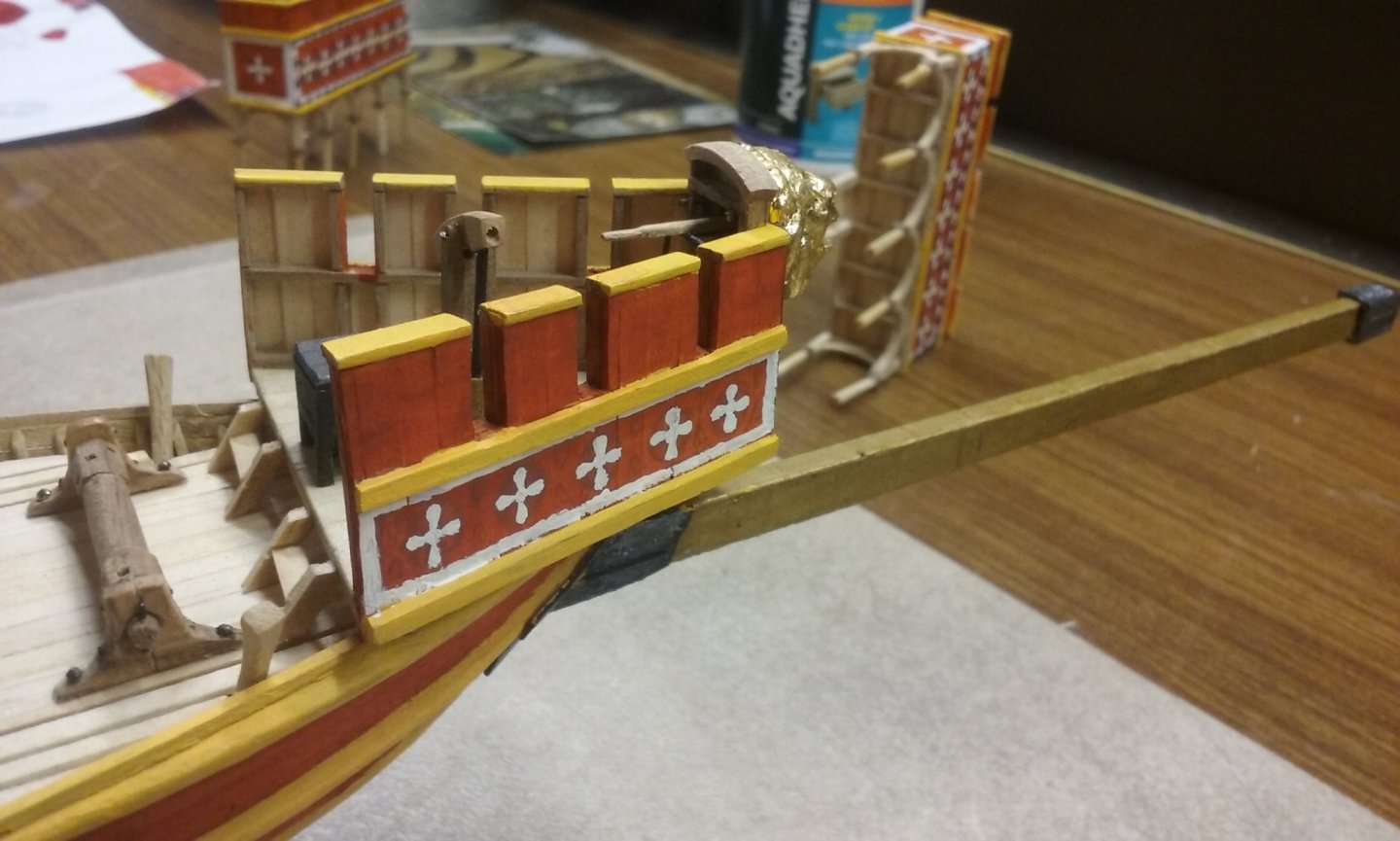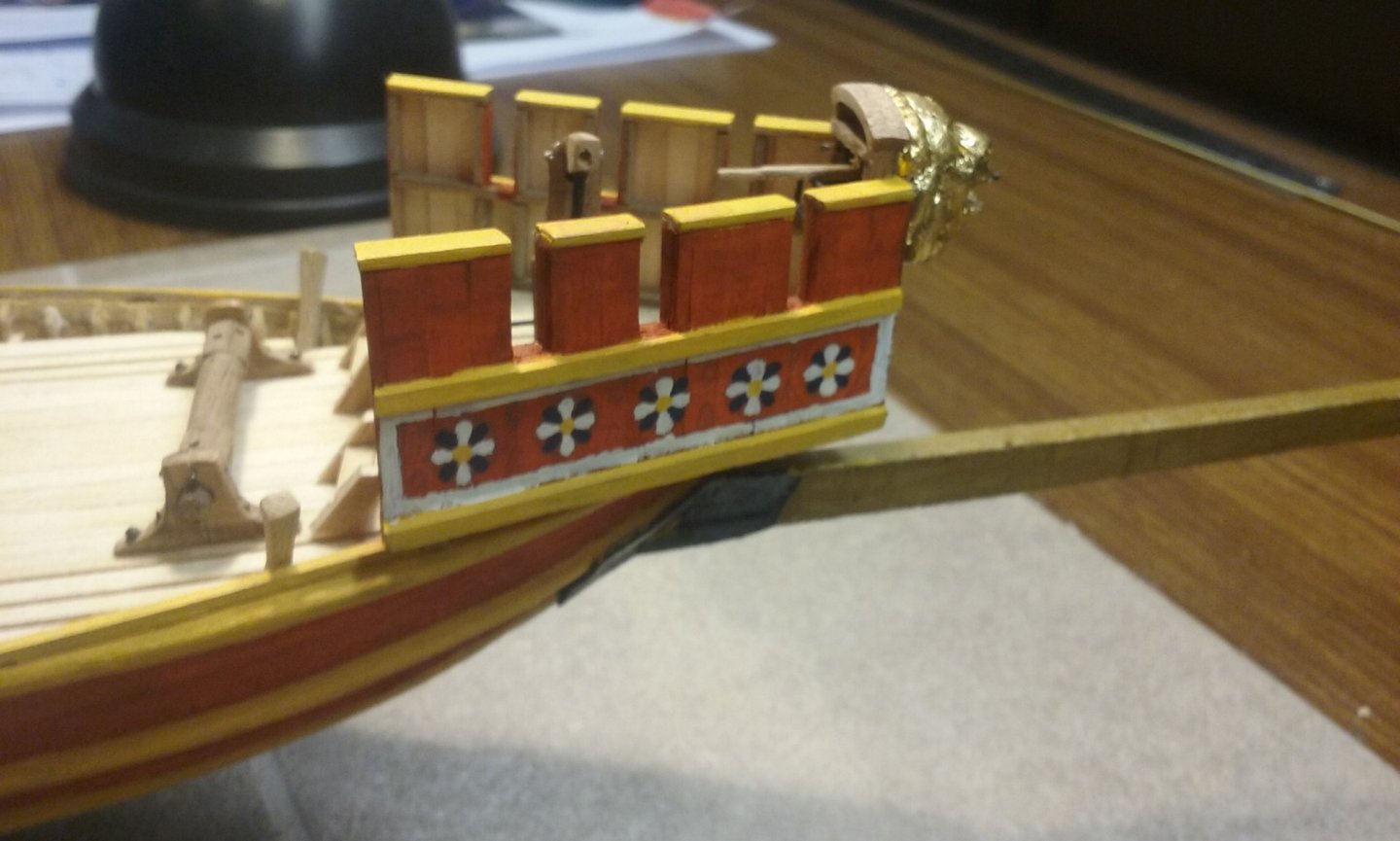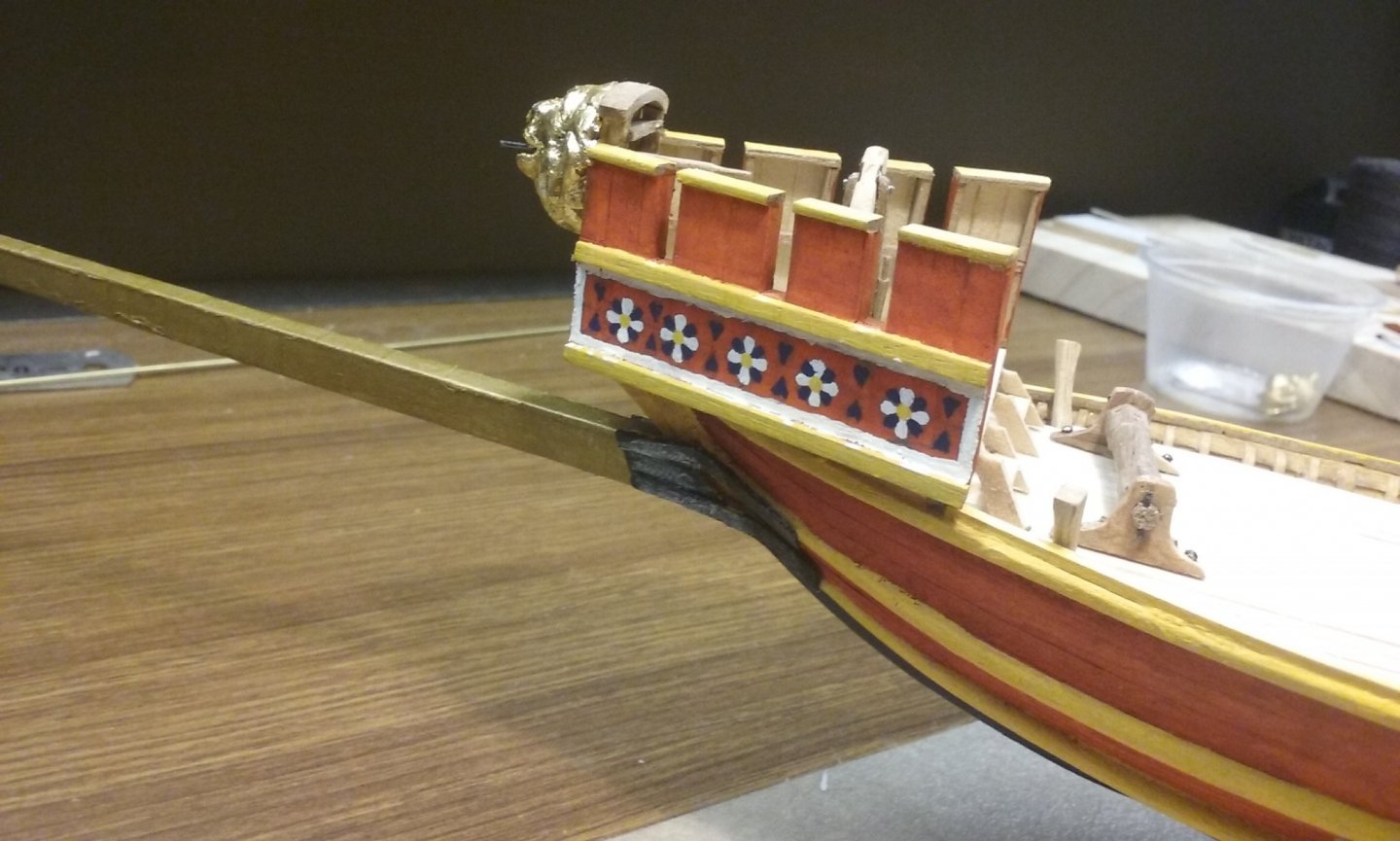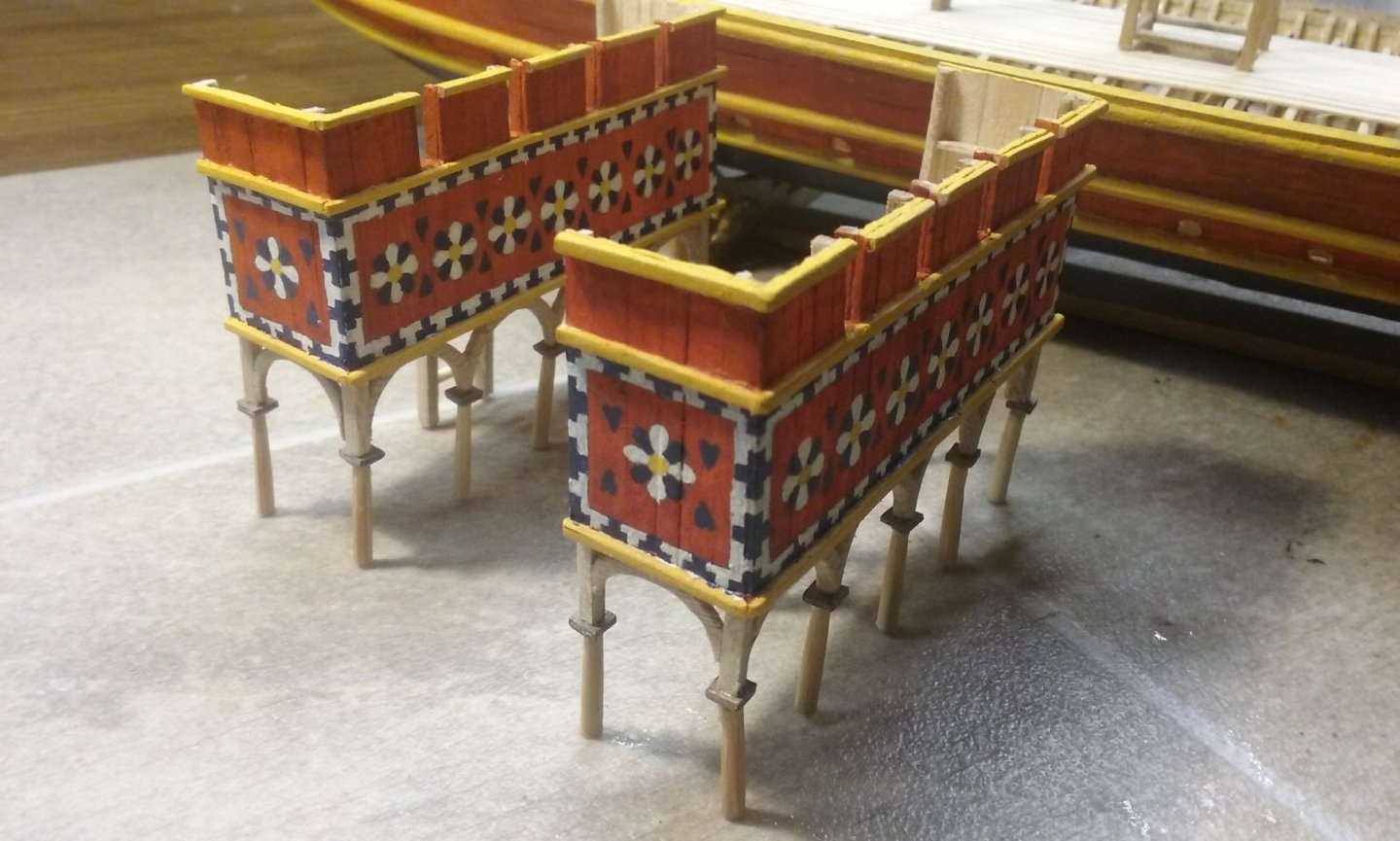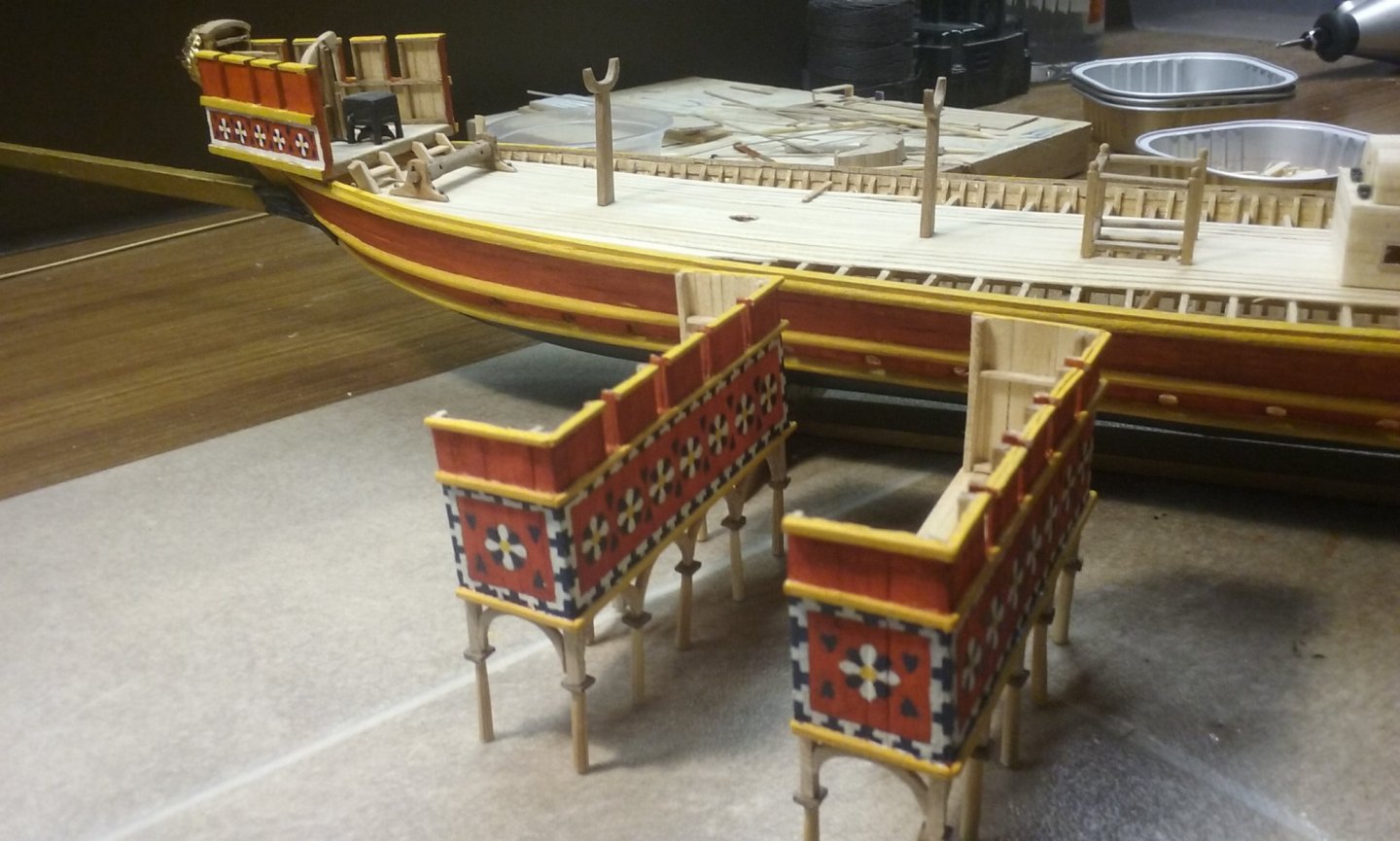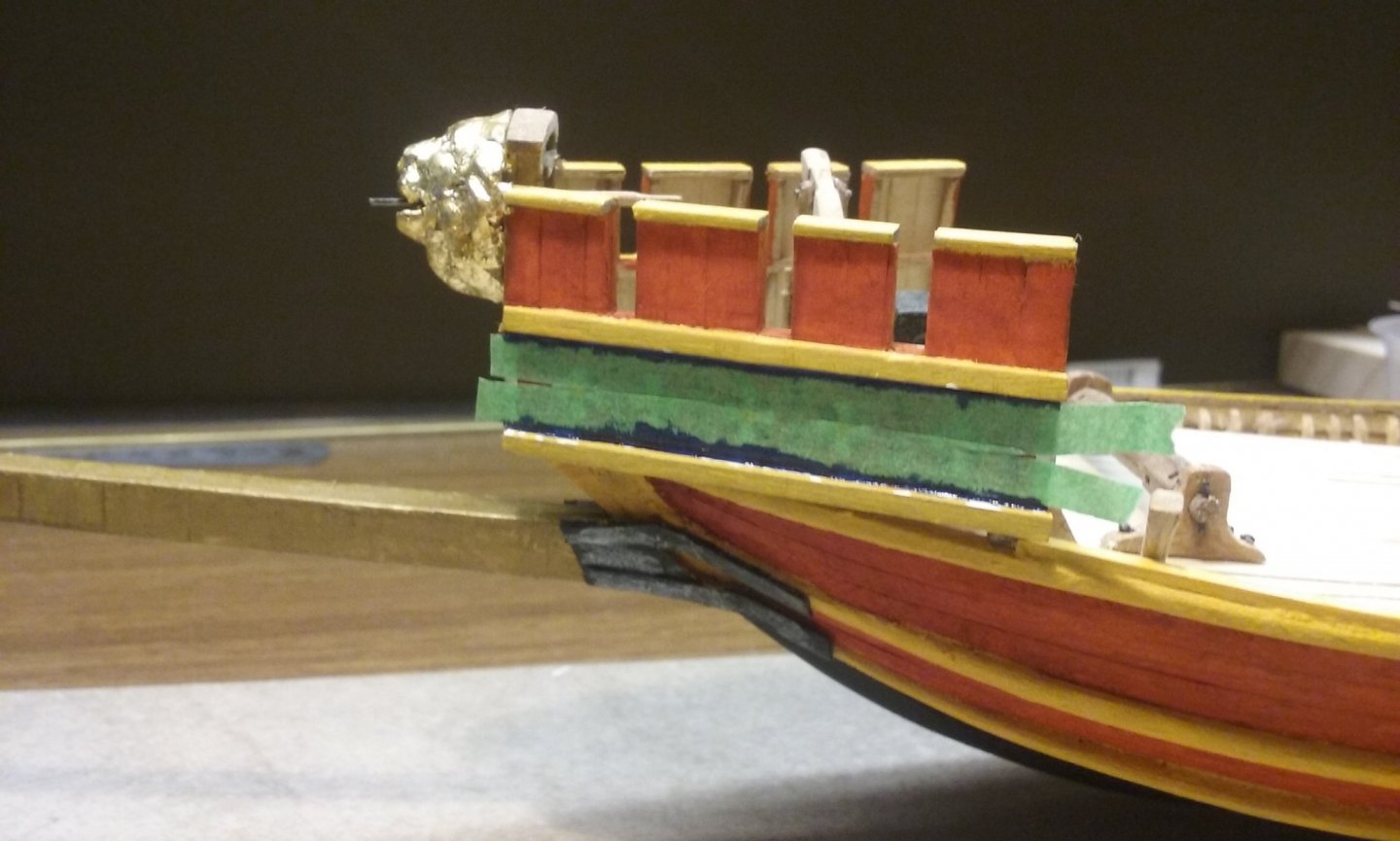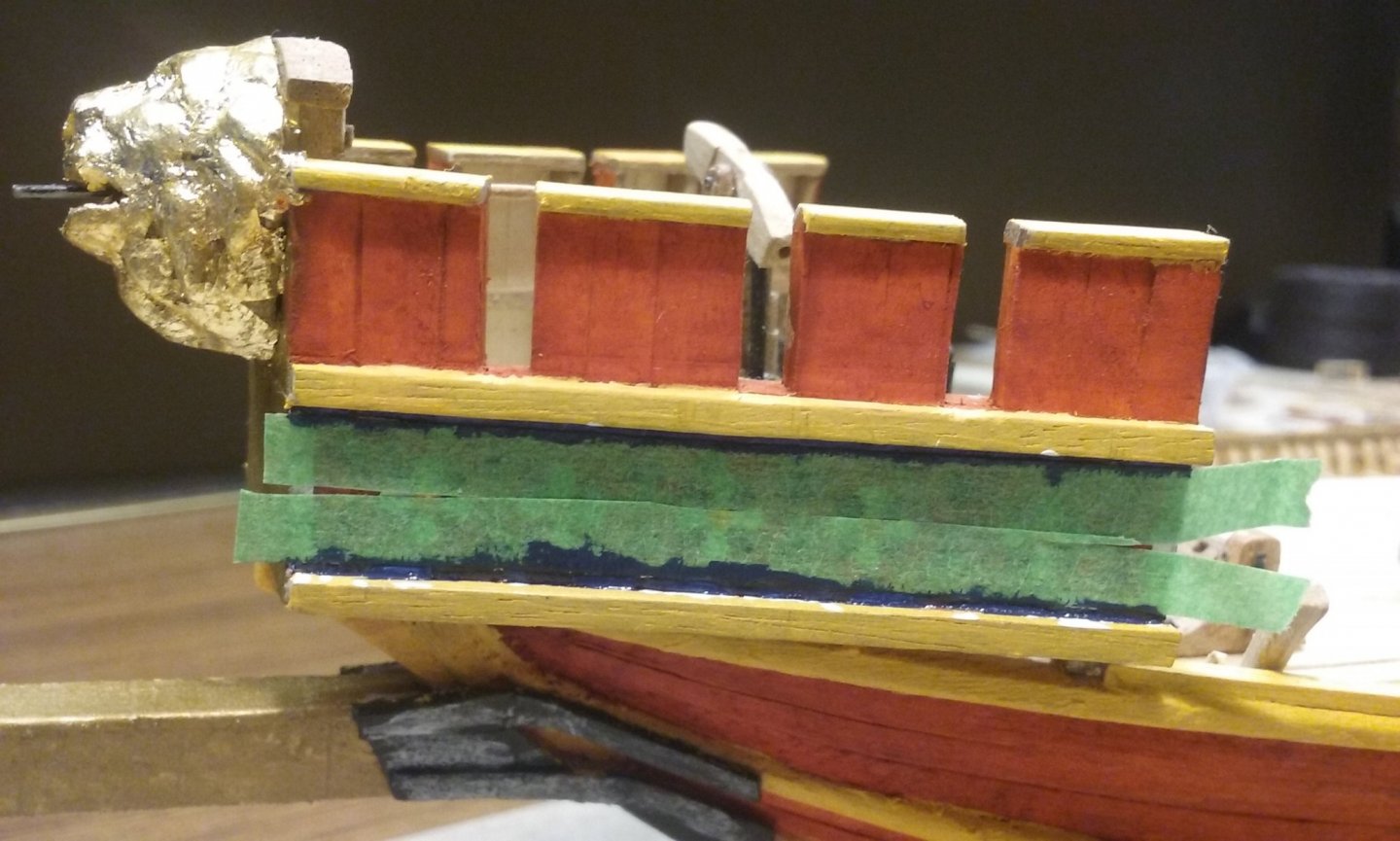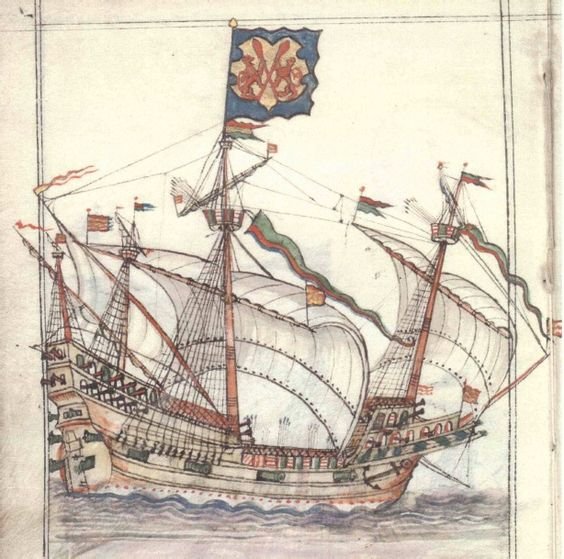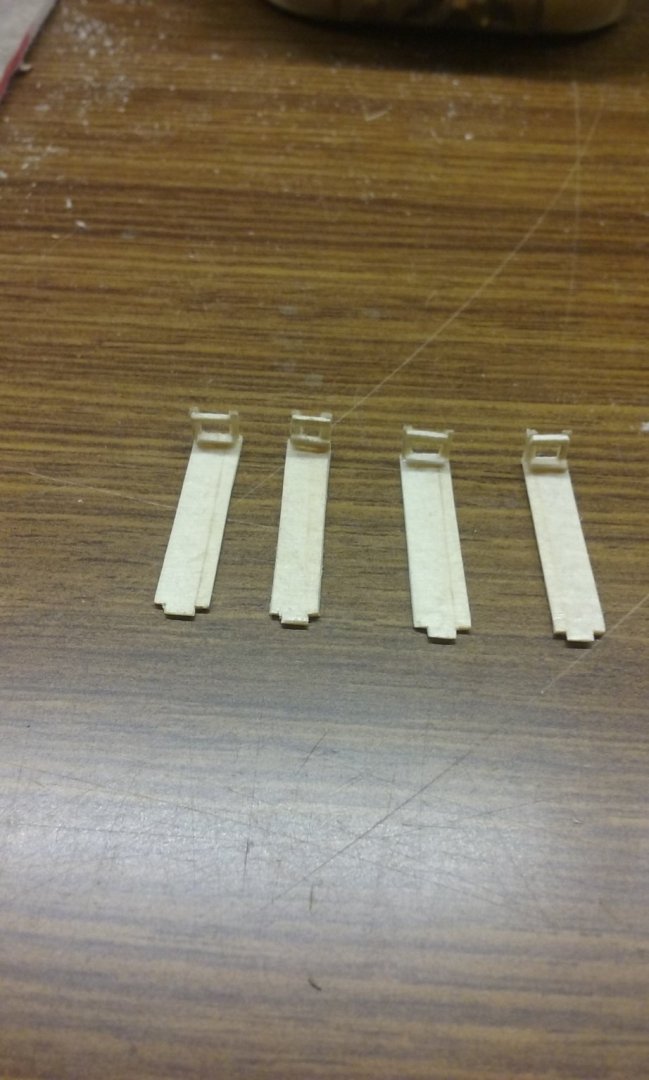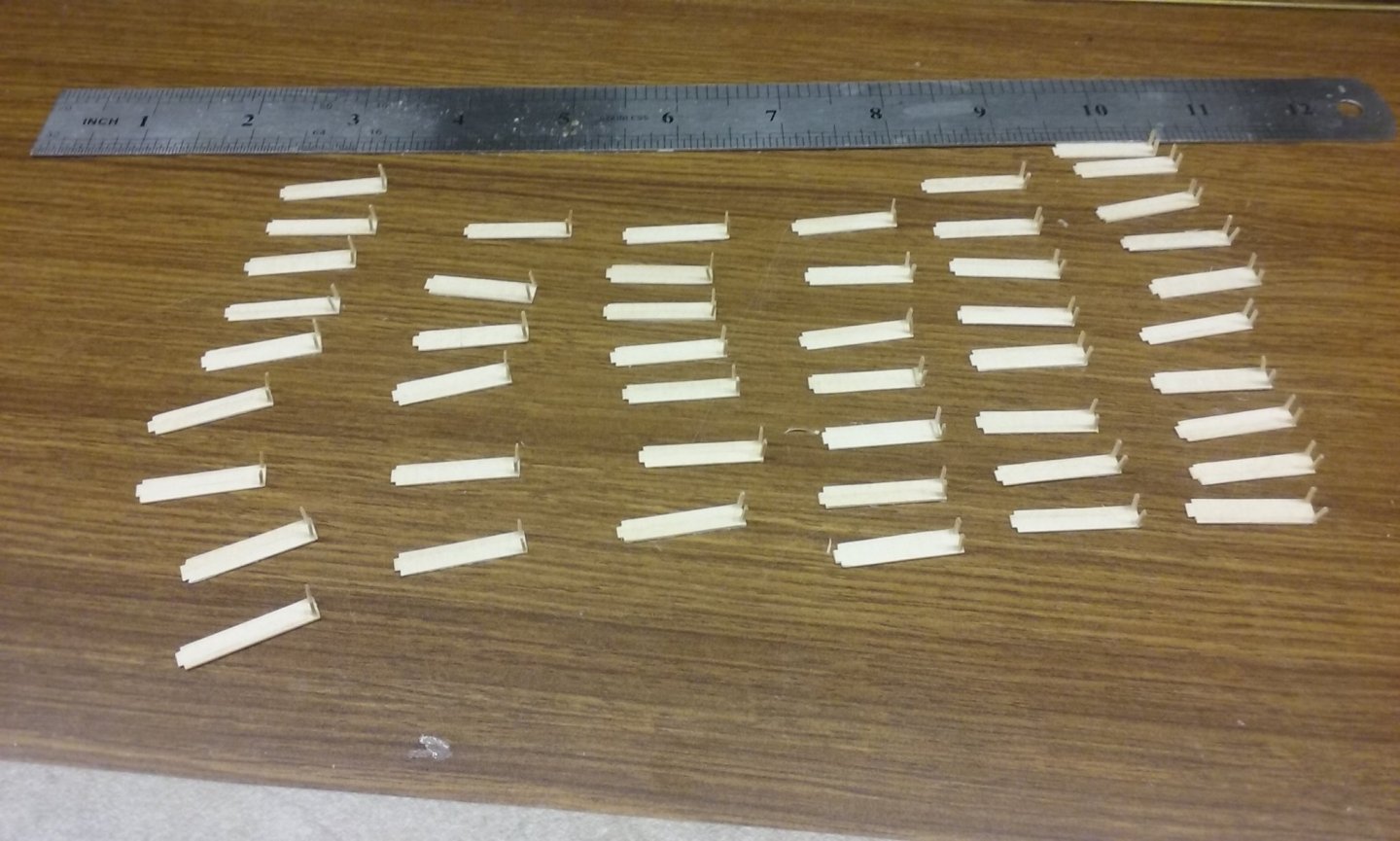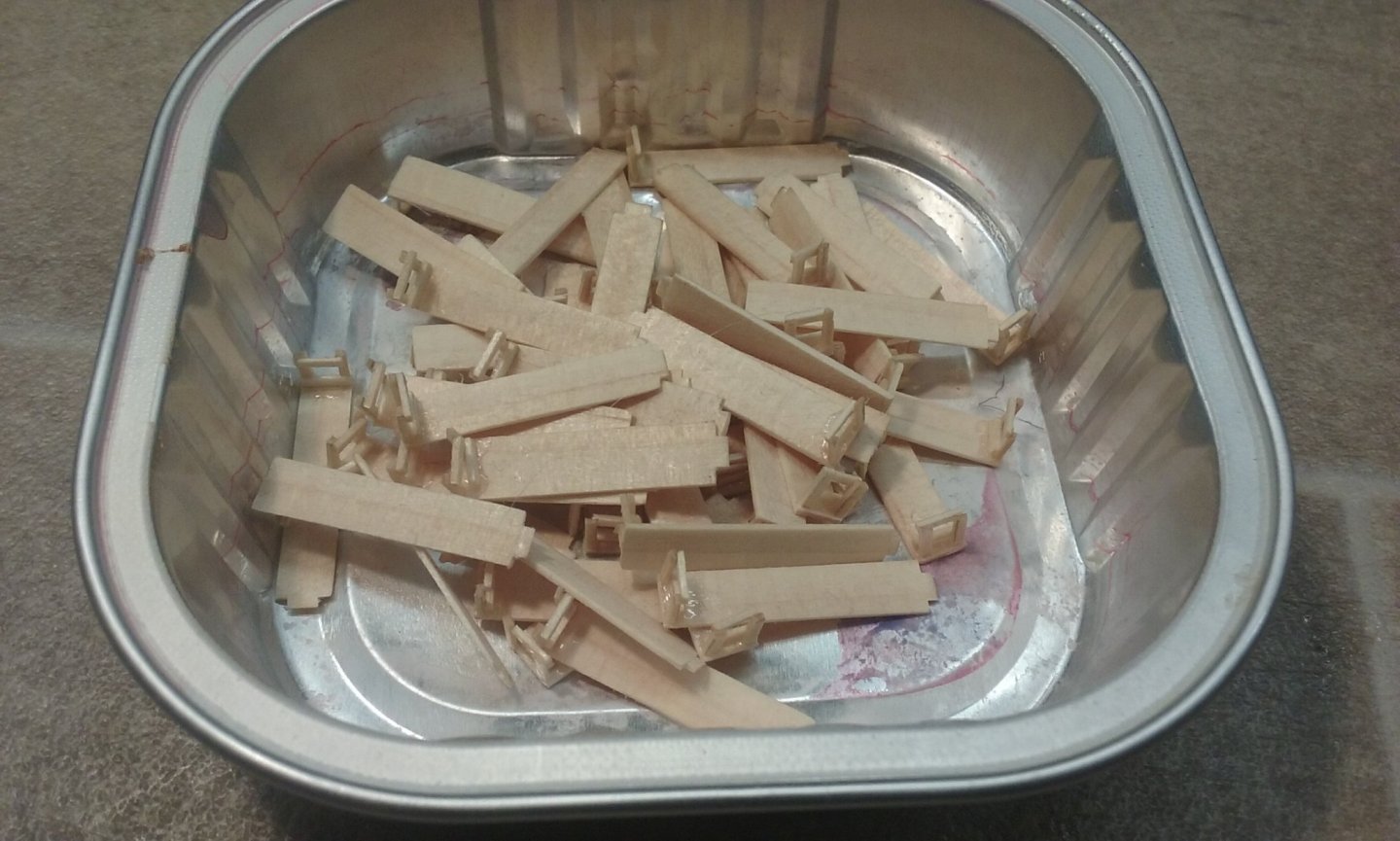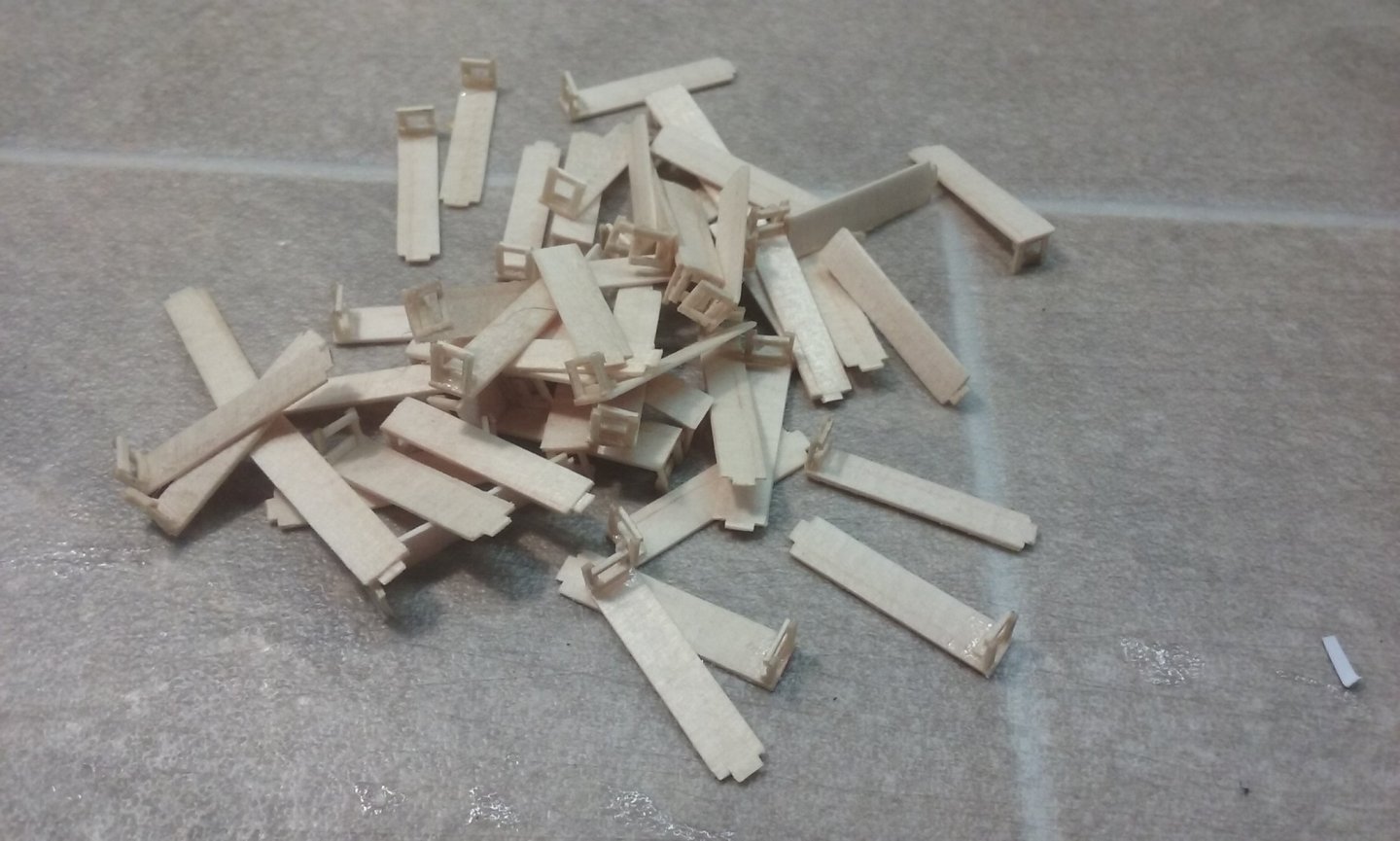-
Posts
7,986 -
Joined
-
Last visited
Content Type
Profiles
Forums
Gallery
Events
Everything posted by Louie da fly
-
Hmm, yes that certainly is a weak point and not surprising it's coming adrift. It's a bit of a design fault on the kit manufacturer's part. Once the boat is built the rest of the structure will hold it all in place quite securely - it's just keeping it from breaking off in the meantime that you have to cope with. Will this part be visible when the model is complete? Because if not, you could glue a "splint" either side of the weak spot to strengthen it (the brown line). If it is going to be visible, the best you can do is glue it as securely as possible and be very careful not to break it off before it's reinforced by the rest of the structure. Regarding the dye, don't forget to do a test run before you dye the sails - it might turn out to be a ghastly colour completely different from what shows on the packet (don't ask me how I know). The plastic parts are just things that would be either too difficult or expensive to make in wood (or would just break the moment you look at them), and as Chris says, with proper prep they'll look just as good as the wood. Regarding the workboat, you might consider building it up on a solid carved base (called a plug), with thin frames bent around it. There are several examples of boats being made this way scattered amongst the build logs, such as archjofo's unbelievably magnificent pinnace for his model of La Créole (well above the efforts of us mere mortals) - starting on the page linked below. Steven
-
https://en.wikipedia.org/wiki/Wyuna
-
Very nice, Backer, and explains the whole thing very well. At first I thought the gonnar didn't have the nerve to stand to his gonne while firing, but the second run of shots using a slow match proved me wrong. A very impressive display. I'd read that these breech loaders were rather inefficient because it was impossible to get a good seal between the cartridge and the barrel, so a lot of the explosive gases escaped instead of propelling the ball. But maybe not, looking at this video. I certainly wouldn't want to be on the wrong end of something like that. It seems to me though, that the gun wasn't built up from wrought iron staves, unless the finish is a lot better than would normally be expected. Maybe because of safety rules? Steven
- 740 replies
-
- Tudor
- restoration
-
(and 4 more)
Tagged with:
-
Roger, I seriously doubt it - I'm working at 1:200 scale - a tiny error at that scale would be enormous in the real world. (But I appreciate the thought ) Mark, thanks for these. There's so much variation in what was in use - the two middle ones are swivels, with the breechblock very evident (and there's a magazine at the bottom of the display). The two bottom ones appear to be stave-built (made of strips of wrought iron edge to edge in a circle to form the barrel), with reinforcing bands shrunk on to keep the thing from blowing apart when fired. The other two - wrought into a tube-shape by a blacksmith? And here's a photo and a diagram of how this breechloader at least worked: And then there are cast bronze guns which were used for the main armament, which were muzzle-loaders much more like those we're all used to, and changed very little over the centuries. According to the Anthony Roll ( https://en.wikisource.org/wiki/Anthony_Roll ) of 1545, the Great Harry had the following crew and guns (numbers in Roman numerals): Men Souldiours - cccxlix Marryna[r]s - cccj Gonnars [gunners] - l [total:] vijc For the Harry Grace a Dieu Ordenaunce, artillary munitions, habillimentes for the warre, for the armyng and in the deffence of the sayd shyppe to the see Gonnes of brasse Cannons - iiij Demy cannons - iij Culveryns - iiij Demy culveryns - ij Sakers - iiij Cannon perers - ij Fawcons - ij Gonnes of yron Porte pecys [port pieces] - xiiij Slynges - iiij Demy slynges - ij Fowlers - viij Baessys - lx Toppe pece - ij Hayle shotte pecys - xl Handgonnes complete - c All in all a fascinating subject. Steven
- 740 replies
-
- Tudor
- restoration
-
(and 4 more)
Tagged with:
-
By the way, these guns are breech-loaders. The narrower bit at the left hand end of the newer one is supposed to represent the "breechblock" where the "magazine" is inserted. Not exactly sure how these things worked, but apparently this is what they looked like. Steven
- 740 replies
-
- Tudor
- restoration
-
(and 4 more)
Tagged with:
-
Well, my technique has improved. Here is a comparison between the first gun barrel I made and the most recent. I've got the reinforcing bands much narrower and (at least in my eye) the whole thing looks better. Note also that the first one is shorter than the last, due to my having got my maths wrong when I scaled it down from the photo. But that really doesn't matter, because all these guns will be sticking out of arched ports in the ship, with the inboard end concealed. And anyway guns of the time were not standardised at all. The new one is the right length, but both are a little too thick (1.5mm brass tube), but not so much that they would be outside the normal variation in gun sizes. The differences in detail are so tiny that they're pretty much invisible to the naked eye. So I'll be keeping all the guns I've made so far and using them in the ship. Steven
- 740 replies
-
- Tudor
- restoration
-
(and 4 more)
Tagged with:
-
Hi Peter, The main thing to do is to sand the first layer of planking so you get a very smooth run in every direction. This is your opportunity to even out any lumps and bumps that disturb the smooth curve of your ship's outer form, to form a good base for your second layer of planking. If there are any gross problems a bit of wood filler or builder's bog is ok to use at this stage (as it will be hidden by the second layer of planking), then sand it all smooth. It seems to me it's already very good, but closer inspection may show up some inequalities that need to be dealt with. It's looking very good, and taking on that beautiful characteristic carrack shape. You're making very good progress. Steven
-
An update on the painting of the pseudopation: Masking: Masking taken off: It does look better to the naked eye than on a close-up photo, but I'm still not totally happy with the precision of the decorated border. However, I think I can improve on it before I finalise the whole thing, add the lower oars and close up the upper deck.
-
I have to make cannons for the aftercastle before I can add the upper deck to it. Back in the day I made a "cast bronze" cannon out of type metal (remember that stuff?) cast in plaster of Paris. I need to do some tidying up and somehow add a trunnion before I can cast more of them. And type metal is completely unavailable nowadays . . . But for the upper deck cannons I'll need "built-up" cannons, as found on the Mary Rose: Here's my first attempt. Not as precise as I'd like, but to the naked eye it looks pretty good. Note the "poor man's lathe", using a very thin file and a tiny hacksaw to cut the grooves. Another 13 to make. And here are the two guns together. Steven
- 740 replies
-
- Tudor
- restoration
-
(and 4 more)
Tagged with:
-

MONTAÑES by Amalio
Louie da fly replied to Amalio's topic in - Build logs for subjects built 1751 - 1800
Exquisite work! -
Beautiful detail work, Dick. Very impressive. Steven
- 263 replies
-
- nave tonda
- round ship
-
(and 2 more)
Tagged with:
-
A very nice bit of planking, Peter. I'll PM you today or tomorrow with my thoughts on the stern Steven
-
(Blush). With the quality of build he's doing, Peter's model deserved something better than the figurehead provided with the kit, and anyway I had a lot of fun doing the carving and painting. And it was very good meeting Peter and Bernie. We had a good time together, and of course Peter and I were able to talk models and compare notes. Ballarat's a bit out of the way (one and a half hour's drive from Melbourne) and it was nice to be able to meet one of my fellow modellers face to face - and we've made two new friends. Steven
-
You're making very good progress with the build; the ship is already looking very attractive, and I'm sure it will look even better when it's finished You're quite right about the words galleon and carrack. People were fairly careless about names at the time and those two terms are what we call them today, not necessarily what they were called. The current understanding of a carrack is a two or three-masted vessel with a round stern as in your second picture above, but certainly the Mary Rose, although she had a flat stern, was in all other respects a carrack, as is the ship in your first photo, which is the earliest flat-sterned carrack I know of. Steven
-
That's a nice bit of planking, Peter - particularly for someone doing a stern as difficult as a carrack's - and planking for the first time. I'm impressed! Steven
-
Thanks for the likes. Druxey, that sounds worthwhile. I'm already committed on this build to the way I've started, but I'll be keeping it in mind for future builds. Christos, many thanks. Steven
-
Thanks everybody for all the likes and the supportive comments. I'm sure the decoration on the full sized ship would have had minor faults and errors, but unfortunately at 1:50 scale they would be all but invisible and I would dearly like to emulate that. I'm fairly happy with it, but I think I can still do better with the geometric borders. We'll see. Druxey, I've used a bow pen in the past but with ink, not with enamel paint. And to be honest I've had my share of bow pen disasters, where all the ink suddenly decides to glob out onto the surface I'm so carefully trying to keep pristine. Also, I don't have a bow pen. The idea's interesting, though. Kikatinalong, that's the only input the cat gets to have - all cats are banned from the boat room, though Louie (the one who supplied the tins) is very sneaky about following me into the room un-noticed and has to be roused out from his hiding place and removed. He did manage to get in once without being noticed at all, and spent quite a bit of time in there without causing any damage, but I don't trust any of the cats further than I could throw the Queen Mary II. Steven
-
Paintwork not finished yet, but coming along. It's a bit frustrating because I really can't go ahead with anything else till I've finished the decorative painting. What I'd like to do is get on with finishing the upper deck and then add the upper benches which I've already made. But I can't do that yet because I've made angled marks below decks to get all the oars at the same angle and I have to be able to see down there to line them up. And if I put the lower bank of oars in first they'll get in the way and make painting the hull and forecastle very difficult. So to finish the decking I have to (1) paint the hull and forecastle and (2) put the lower oars in. So, here's current progress with the painting. Xylokastra (side castles): Still some more tidying up to do on the decorative paintwork, but one relief is that I've realised that as they aren't yet in place I don't have to do it till later if I don't want to. Here is the pseudopation (forecastle): Oh, and I've straightened out the wobbly white lines at the edges and for the blue lines I've done some masking - which I should have done before - to overcome much of the problem caused by my shaky hands. (Here's hoping it works!) Steven
-
Apxeos, that is definitely a galleon. Since the carrack that preceded the galleon was often referred to as a nao, people assume it means a specific type of vessel, when in fact nao just means ship. You might be interested in this one as well - French, from 1548. And these ones, also French, from 1545. You're doing very well with it. I'll be following this build with great interest. Steven
-
Yes, that's pretty much what I do. Unfortunately my aspirations for the painting seem a little higher than my ability for precision. I'll do the best I can and tweak it till I get it as good as I'm able to, but I think there'll be a point where I have to say "that's as good as I can do" and leave it at that. Nikiforos, I'm quite happy with acrylic - I used it on the carved figures and had intended to do the same with the hull, but I've found acrylic over the top of PVA glue shows up marks that stand out like a dunny in the desert, so I had to use enamel instead. I used enamel on my Great Harry model way back in the day - Humbrol was available and acrylics certainly were not. Unfortunately the rust red enamel I've used on most of the hull goes gluggy and won't give good coverage over other colours, so when fine line of white, or worse still, the dark blue on the "hearts" goes outside the line, it's difficult to touch it up. I've tried three different tins and they all have the same problem. It's rather annoying. Still, one can only do one's best. Steven
-
I've been working on the upper oarbenches - very tedious work - and I'm finally finished. It's a little bit previous, because I don't yet have a completed deck to put them on, but it's been my relief when I get tired (after about 5 minutes!) of doing the fiddly painted decoration on the castles. I can't put the deck on till the painting's finished, but it's at least something I can do in the meantime. There are only two legs, at the inboard end of each bench. The outboard end has a tenon that fits into a mortise in the gunwale. Legs attached: Just butt-glued together. I wasn't too careful about keeping the legs perpendicular to the bench, because I had a cunning plan to straighten everything at the next step: The crosspieces made sure the legs weren't splayed apart, and I "broke" the bond between the legs and the bench as I glued the upper crosspiece on, so the final joint was square and straight. Not too shabby. Fairly pleased with it. Now I have to finish off the fiddly painted decoration. I've got the finest brushes I can, but the faults lie more with my shaky hands than with the brush. There are still bits I'm not satisfied with, but I'll be tweaking the paintwork till I'm happy with it. More to come . . . Steven
-
Wonderful work, Luponero. The only question I have is - where did you get that enormous blue-headed pin? Steven
- 197 replies
-
- santa maria
- carrack
-
(and 1 more)
Tagged with:
About us
Modelshipworld - Advancing Ship Modeling through Research
SSL Secured
Your security is important for us so this Website is SSL-Secured
NRG Mailing Address
Nautical Research Guild
237 South Lincoln Street
Westmont IL, 60559-1917
Model Ship World ® and the MSW logo are Registered Trademarks, and belong to the Nautical Research Guild (United States Patent and Trademark Office: No. 6,929,264 & No. 6,929,274, registered Dec. 20, 2022)
Helpful Links
About the NRG
If you enjoy building ship models that are historically accurate as well as beautiful, then The Nautical Research Guild (NRG) is just right for you.
The Guild is a non-profit educational organization whose mission is to “Advance Ship Modeling Through Research”. We provide support to our members in their efforts to raise the quality of their model ships.
The Nautical Research Guild has published our world-renowned quarterly magazine, The Nautical Research Journal, since 1955. The pages of the Journal are full of articles by accomplished ship modelers who show you how they create those exquisite details on their models, and by maritime historians who show you the correct details to build. The Journal is available in both print and digital editions. Go to the NRG web site (www.thenrg.org) to download a complimentary digital copy of the Journal. The NRG also publishes plan sets, books and compilations of back issues of the Journal and the former Ships in Scale and Model Ship Builder magazines.



